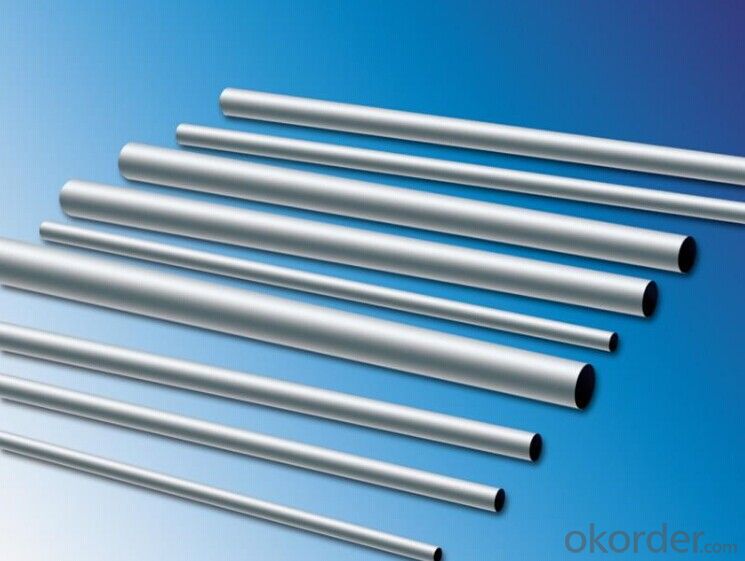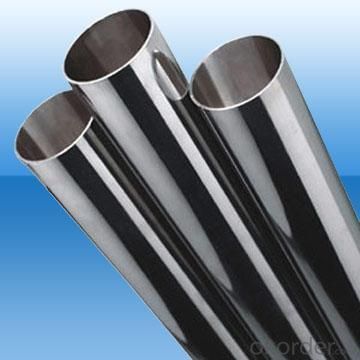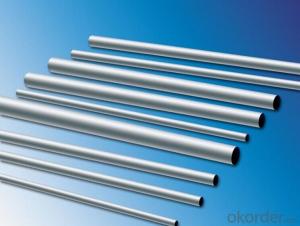Round Section Hot Rolled Stainless Steel Pipe MOQ 30MT
- Loading Port:
- Tianjin
- Payment Terms:
- TT OR LC
- Min Order Qty:
- 30 m.t.
- Supply Capability:
- 3000 m.t./month
OKorder Service Pledge
OKorder Financial Service
You Might Also Like
Item specifice
Round Section Hot Rolled Stainless Steel Pipe MOQ 30MT
1.Structure of Stainless Steel Pipe :
Stainless steel pipe is formed by drawing a solid billet over a piercing rod to create the hollow shell. As the manufacturing process does not include any welding, seamless pipes are perceived to be stronger and more reliable. Historically seamless pipe was regarded as withstanding pressure better than other types, and was often more easily available than welded pipe.
2.Main Features of the Stainless Steel Pipe :
• High manufacturing accuracy
• High strength
• Small inertia resistance
• Strong heat dissipation ability
• Good visual effect
• Reasonable price
3.Stainless Steel Pipe Specification:
Standard | GB, DIN, ASTM ASTM A106-2006, ASTM A53-2007 |
Grade | 10#-45#, 16Mn 10#, 20#, 45#, 16Mn |
Thickness | 8 - 33 mm |
Section Shape | Round |
Outer Diameter | 133 - 219 mm |
Place of Origin | Shandong, China (Mainland) |
Secondary Or Not | Non-secondary |
Application | Hydraulic Pipe |
Technique | Cold Drawn |
Certification | API |
Surface Treatment | factory state or painted black |
Special Pipe | API Pipe |
Alloy Or Not | Non-alloy |
Length | 5-12M |
Outer Diameter | 21.3-610mm |
Grade | 20#, 45#, Q345, API J55, API K55, API L80, API N80, API P110, A53B |
Standard | ASME, ASTM |
1) Material:20#(ASTM A 106/A53 GRB.API5LGRB,GB),45#,16Mn,10#.
2) Specification range:OD:21.3-610mm,WT:6-70mm,length:6-12m or according to the requirement of clients.
3) Excutive standards:GB,ASME API5L.ASTM A 106/A53,Despite of the above standards,we can also supply seamless steel pipe with standard of DIN,JIS,and so on,and also develop new products according to the requirements of our clients!
4) Surface:black lacquered,varnish coating or galvanized.
5) Ends:Beveled or square cut,plastic capped,painted.
6) Packing:bundles wrapped with strong steel strip,seaworthy packing.
4. Application of Stainless Steel Pipe
Stainless steel pipe is used for structural and piping applications that require the properties that stainless steel delivers – high strength, toughness and excellent corrosion resistance. The pipe is available in sizes 1/2" through 36” in outside diameter (OD) and schedules 05S through 80S and larger for wall thickness (WT). It is available as welded and seamless. Stainless pipe has a dull gray, mill finish.
5.Packaging & Delivery
Packaging Details: | seaworthy package,bundles wrapped with strong steel strip |
Delivery Detail: | 50-60days after received 30%TT or Original LC |
6.FAQ of Stainless Steel Pipe :
A. How is the quality of your products?
Our products are manufactured strictly according to national and internaional standard, and we take a test on every pipe before delivered out. If you want see our quality certifications and all kinds of testing report, please just ask us for it.
Guaranteed: If products’ quality don’t accord to discription as we give or the promise before you place order, we promise 100% refund.
trust the quotation we would give you, it is professional one.
B. Why should you chose us?
Chose happens because of quality, then price, We can give you both.Additionally, we can also offer professional products inquiry, products knowledge train(for agents), smooth goods delivery, exellent customer solution proposals.Our service formula: good quality+good price+good service=customer’s trust
SGS test is available, customer inspection before shipping is welcome, third party inspection is no problem.
Any question, pls feel free to contact us !
7. Seamless Pipe ASTM A106/53 Images:


8. Company Information:
CNBM International Corporation (CNBM International) is the most important trading platform of CNBM Group Corporation, a state-owned company under the direct supervision of State-owned Assets Supervision and Administration Commission of the State Council.
In line with the business, CNBM International launched E-business platform Okorder.com.Our goal is to transform CNBM International into the global leading brand in building materials industry within 3 to 5 years through innovation and reform, by strengthening the overall management of supply chain, developing and cultivating both domestic and overseas market, improving the procedure and information system, enhancing the ability to organize resources and to provide value-added services under a professional team and a learning organization.
- Q:What's the difference between stainless steel pipe and stainless steel composite pipe?
- Stainless steel is also divided into several kinds of 200201300301304,The market is generally 301 material, 304 of the best results, followed by 301.
- Q:Can stainless steel pipes be used for solar energy systems?
- Indeed, solar energy systems can utilize stainless steel pipes. The versatility and durability of stainless steel make it well-suited to endure the challenging conditions of such systems. Its resistance to corrosion is particularly vital for ensuring the longevity of pipes in outdoor and exposed environments. Moreover, stainless steel pipes possess exceptional heat resistance capabilities, rendering them suitable for transporting hot fluids within solar energy systems. Furthermore, stainless steel's high strength-to-weight ratio makes it an ideal choice for supporting the weight of solar panels or other components in the system. In summary, stainless steel pipes prove to be a dependable and effective option for solar energy systems.
- Q:How do you prevent freezing in stainless steel pipes?
- There are several measures that can be taken to prevent freezing in stainless steel pipes: 1. Insulating the pipes is a highly effective method. You can wrap the pipes with insulation sleeves or use foam pipe insulation. This will help maintain the pipes' temperature and prevent them from becoming too cold. 2. Heat tracing is another effective technique. This involves installing electric heat cables along the pipes' length. These cables generate heat and keep the pipes warm, thus preventing freezing. 3. It is crucial to maintain a constant temperature in the area where the stainless steel pipes are located. If the pipes are exposed to extreme cold temperatures, make sure to heat the area properly. You can use space heaters or insulate the surrounding walls to retain heat. 4. Keeping the water flowing through the pipes is essential. Moving water is less likely to freeze compared to stagnant water. If the pipes are used for water transportation, ensure that the water keeps flowing, even if it's just a small trickle. This continuous flow will help prevent freezing. 5. Check for any air leaks or drafts around the stainless steel pipes. Cold air entering the space can cause the pipes to freeze. Seal any gaps or cracks with weatherstripping or caulk to prevent cold air from entering. 6. Monitoring the temperature in the area where the stainless steel pipes are located is important. Install a thermometer to keep track of the temperature. This will help identify any potential freezing risks and allow you to take necessary precautions in advance. By implementing these preventive measures, you can effectively safeguard your stainless steel pipes from freezing and avoid potential damage.
- Q:How do you calculate the heat transfer coefficient of stainless steel pipes?
- The heat transfer coefficient of stainless steel pipes can be determined through a variety of methods, including empirical correlations and theoretical calculations. One popular empirical correlation is the Dittus-Boelter equation, which establishes a relationship between the heat transfer coefficient, Reynolds number, and Prandtl number. The equation is as follows: Nu = 0.023 * Re^0.8 * Pr^0.4 In this equation, Nu represents the Nusselt number, Re represents the Reynolds number, and Pr represents the Prandtl number. The Nusselt number is a dimensionless quantity that signifies the ratio of convective to conductive heat transfer. To calculate the Reynolds number, the following formula is used: Re = (ρ * v * D) / μ Here, ρ denotes the fluid's density, v represents the fluid's velocity, D is the hydraulic diameter of the pipe, and μ represents the fluid's dynamic viscosity. The Prandtl number can be determined using the equation: Pr = μ * Cp / k In this equation, Cp stands for the specific heat capacity of the fluid, while k represents the fluid's thermal conductivity. Once the Reynolds and Prandtl numbers are determined, they can be substituted into the Dittus-Boelter equation to calculate the Nusselt number. Finally, the heat transfer coefficient can be obtained by multiplying the Nusselt number by the fluid's thermal conductivity and dividing it by the hydraulic diameter of the pipe: h = (Nu * k) / D In this equation, h represents the heat transfer coefficient. It is essential to note that these calculations are based on assumptions and empirical correlations. Actual heat transfer coefficients may vary due to factors such as pipe roughness, fluid properties, and flow conditions. Therefore, it is advised to consult relevant heat transfer literature or conduct experimental studies for more precise results.
- Q:What are the different types of stainless steel pipe supports?
- Various industries and applications commonly utilize several types of stainless steel pipe supports. These options include: 1. Adjustable pipe supports: These supports facilitate easy adjustment of pipe position or height. They often feature a threaded rod or telescoping design for accommodating different pipe sizes or installation requirements. 2. Pipe hangers: These supports suspend pipes from overhead structures. They typically consist of a metal bracket or clamp attached to a beam or structural element, along with a hanging rod or strap that bears the pipe's weight. 3. Pipe clamps: These supports secure pipes to walls, floors, or surfaces. They usually consist of a metal clamp wrapped around the pipe and affixed to the surface using screws or bolts. Pipe clamps can be adjustable or fixed, depending on the application. 4. Pipe saddles: These supports cradle or uphold pipes on horizontal surfaces. They generally consist of a U-shaped metal bracket or saddle attached to the surface, supplemented with a cushioning material like rubber or neoprene to prevent pipe damage. 5. Pipe guides: These supports guide or control pipe movement, particularly in situations where thermal expansion or contraction is a concern. They usually comprise a metal bracket or guide fixed to a structure, along with a sliding or rolling element that allows the pipe to move while maintaining alignment. Each specific type of stainless steel pipe support possesses distinct advantages and is designed to fulfill unique installation requirements. The selection of a support depends on factors such as pipe material, size, weight, and specific application needs.
- Q:Can stainless steel pipes be used for food storage tanks?
- Yes, stainless steel pipes can be used for food storage tanks. Stainless steel is a preferred material for food storage and processing equipment due to its excellent corrosion resistance, durability, and hygiene properties. It is non-reactive, does not leach any harmful substances into the food, and can withstand high temperatures and rigorous cleaning processes. Additionally, stainless steel pipes can be easily cleaned and sanitized, ensuring the maintenance of proper food safety standards. Therefore, stainless steel pipes are commonly used in the construction of food storage tanks to ensure the safety and quality of stored food products.
- Q:What is the difference between Schedule 30 and Schedule 40 stainless steel pipes?
- Schedule 30 and Schedule 40 are two different classifications of stainless steel pipes based on their wall thickness and pressure ratings. The main difference between Schedule 30 and Schedule 40 stainless steel pipes lies in their wall thickness. Schedule 30 stainless steel pipes have a thinner wall compared to Schedule 40 pipes. The wall thickness of Schedule 30 pipes is generally less than that of Schedule 40 pipes. This means that Schedule 30 pipes have a larger internal diameter compared to Schedule 40 pipes for the same nominal size. The thickness of the pipe walls directly affects the pressure rating and strength of the pipe. Schedule 40 stainless steel pipes are designed to handle higher pressure and have higher structural integrity due to their thicker walls. They are commonly used in applications where high-pressure fluids or gases are being transported, such as in industrial settings or for plumbing systems in commercial buildings. On the other hand, Schedule 30 stainless steel pipes are typically used in applications where the pressure requirements are lower. They are suitable for applications with more moderate pressure demands or where the fluid being transported does not require a higher pressure rating. In summary, the main difference between Schedule 30 and Schedule 40 stainless steel pipes is their wall thickness, with Schedule 40 pipes having thicker walls and higher pressure ratings compared to Schedule 30 pipes. The choice between the two depends on the specific requirements of the application, including the pressure and fluid being transported.
- Q:How do you calculate the pressure rating of stainless steel pipes?
- To calculate the pressure rating of stainless steel pipes, you need to consider several factors. First, you need to know the material properties of the stainless steel being used, such as its yield strength and tensile strength. These properties can be obtained from material data sheets or by conducting mechanical tests. Next, you need to determine the wall thickness of the stainless steel pipe. This can be measured directly or obtained from the pipe manufacturer's specifications. It is important to ensure that the wall thickness is uniform along the entire length of the pipe. Once you have the material properties and the wall thickness, you can use the appropriate formula or calculation method to determine the pressure rating. There are various codes and standards available that provide guidance on calculating pressure ratings for different types of pipes, such as the ASME B31.3 code for process piping or the ASME B31.1 code for power piping. These codes typically consider factors such as the allowable stress of the material, safety factors, and design considerations. The formulas or calculation methods provided in these codes take into account the material properties, wall thickness, pipe diameter, and other relevant parameters to calculate the maximum allowable pressure that the stainless steel pipe can withstand. It is important to note that the pressure rating of stainless steel pipes may also depend on other factors, such as the temperature of the fluid being transported, the corrosive nature of the fluid, and any potential external loads or stresses on the pipe. Therefore, it is recommended to consult the applicable codes, standards, or a qualified engineer to ensure accurate calculations and to consider all relevant factors when determining the pressure rating of stainless steel pipes.
- Q:Can stainless steel pipes be used for vacuum systems?
- Yes, stainless steel pipes can be used for vacuum systems. Stainless steel is highly resistant to corrosion and has high strength, making it suitable for maintaining a vacuum environment without compromising its integrity.
- Q:What is the difference between 904L and 2205 stainless steel pipes?
- 904L and 2205 are both types of stainless steel pipes, but they have some key differences. Firstly, the composition of the two steels is different. 904L stainless steel is a high alloy austenitic stainless steel that contains high levels of chromium, nickel, and molybdenum. It also has low carbon content, making it highly resistant to corrosion and pitting. On the other hand, 2205 stainless steel is a duplex stainless steel that consists of a mixture of austenite and ferrite phases. It contains lower levels of chromium and nickel compared to 904L, but has higher levels of molybdenum and nitrogen. Secondly, the mechanical properties of the two steels differ. 904L stainless steel has excellent toughness and high strength, making it suitable for applications in aggressive environments such as chemical processing plants and offshore oil and gas platforms. In contrast, 2205 stainless steel has good overall mechanical properties, with high tensile and yield strength. It is commonly used in industries such as marine, paper, and pulp, where resistance to stress corrosion cracking is important. Another difference lies in their resistance to corrosion. While both steels are corrosion-resistant, 904L stainless steel has exceptional resistance to a wide range of corrosive environments, including sulfuric acid, hydrochloric acid, and saltwater. This makes it ideal for use in industries where extreme corrosion resistance is required. 2205 stainless steel, although not as corrosion-resistant as 904L, still offers good resistance to many corrosive substances, making it suitable for various applications. Cost is another factor that sets these steels apart. Due to its high alloy content and superior properties, 904L stainless steel is generally more expensive than 2205 stainless steel. Therefore, the choice between the two will depend on the specific requirements of the application and the budget. In summary, the main differences between 904L and 2205 stainless steel pipes lie in their composition, mechanical properties, corrosion resistance, and cost. Understanding these distinctions will help in selecting the appropriate stainless steel pipe for a given application.
1. Manufacturer Overview |
|
|---|---|
| Location | |
| Year Established | |
| Annual Output Value | |
| Main Markets | |
| Company Certifications | |
2. Manufacturer Certificates |
|
|---|---|
| a) Certification Name | |
| Range | |
| Reference | |
| Validity Period | |
3. Manufacturer Capability |
|
|---|---|
| a)Trade Capacity | |
| Nearest Port | |
| Export Percentage | |
| No.of Employees in Trade Department | |
| Language Spoken: | |
| b)Factory Information | |
| Factory Size: | |
| No. of Production Lines | |
| Contract Manufacturing | |
| Product Price Range | |
Send your message to us
Round Section Hot Rolled Stainless Steel Pipe MOQ 30MT
- Loading Port:
- Tianjin
- Payment Terms:
- TT OR LC
- Min Order Qty:
- 30 m.t.
- Supply Capability:
- 3000 m.t./month
OKorder Service Pledge
OKorder Financial Service
Similar products
New products
Hot products
Related keywords




























